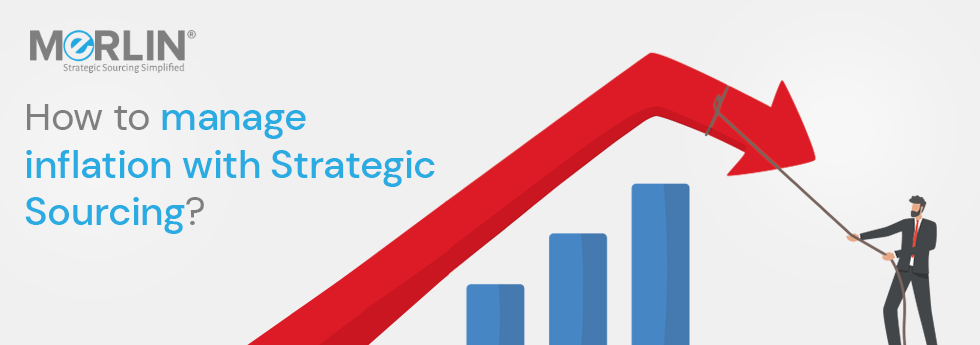Inflation is likely to persist as one of the biggest economic problems in 2023 with the highest rates that the world has seen in the past 40 years. The economic downturn post-pandemic, supply shortages, the Russia – Ukraine war and its impact on oil prices are all factors that contributed to the rise in inflation. Experts predict the worst is yet to come and for many 2023 will feel like a recession. Now, with inflation expected to remain high, businesses are frantically looking at procurement teams for solutions to curb inflation. Strategic Sourcing is a great weapon that organizations can leverage to manage inflation.
In this blog we’ll discuss:
- What impact does inflation have on sourcing and procurement?
- How can procurement teams minimize the effect of inflation with strategic sourcing?
- Digital procurement solutions for managing inflation.
Inhaltsverzeichnis
ToggleImpact of Inflation on Sourcing & Procurement Functions
Inflation has a direct impact on sourcing with prices skyrocketing for commodities . The constraint in the supply chain for resources and services forces several businesses to increase prices which further worsens the decline in demand. Additionally, the consequences of inflation don’t stop here, they extend to capacity constraints, unstable supplies, longer lead times, and delay in orders. Thus, -inflation puts procurement at a fix where they must balance the potential for reducing consumer demands while simultaneously ensuring continuity of supply, maintaining supplier relationships and managing costs effectively.
In situations like this where supply is limited and suppliers appear to have greater control in terms of prices, how can procurement make the greatest impact? The answer is Strategische Beschaffung!
How can Procurement Minimize the Effects of Inflation with Strategic Sourcing?
An effective strategy against the unpredictability of price variations brought by inflation can be addressed by strategic sourcing techniques in terms of cost savings and cost reductions. Such techniques call for going above and beyond the typical aspects, such as bottom-line cost changes, adopting innovative supplier sourcing strategy, periodic improvement plans, and designing a systematic strategy that connects the dots both within the company and throughout the sourcing process. Organizations may follow some of the strategic sourcing practices mentioned below to manage inflation:

Refresh sourcing strategies
Major procurement organizations are implementing more advanced, cutting-edge sourcing techniques, such as leveraging their pricing, or carefully modifying the company’s specifications and requirements to save expenses when the ROI does not support more spending. In cases when there are many contractual suppliers for a given spend category, strategic sourcing may help to reallocate volume to benefit from the best prices. It also provides an opportunity to return to the market faster and find new suppliers with more fair prices to further minimize the cost pressure. Other strategies like direct is where an organization enters into a number of supplier contracts with varying term lengths, fixed and variable costs, and make staggered purchases to even out total costs and manage volatility, holding-inventory, consortium buying, etc. can also help to minimize the impact of inflation and shortages.
Asses and Manage risks
Your procurement department may reduce risk, especially in times of inflation, by appropriately managing and monitoring risks across important vendors or spend categories. The strategies for risk mitigation may include improved supplier business continuity strategies, selecting addition techniques to the inventory, or identifying appropriate pre-screened substitute suppliers for sourcing and so on.
Enhance supplier relationship management and collaboration
In this hyper inflationary market, businesses frequently switch between several suppliers to find the best deals using spot buying methods. Despite the fact that this method seems to be cost-effective, it really creates long-term instability in supplier relationships since it does not address the market circumstances that cause price fluctuation. By implementing Supplier relationship management (SRM) techniques companies can identify a selected number of preferred suppliers based on price, quality, capacity, knowledge, and reliability that help them discover the underlying cost components for the products. Also, by strengthening their relationships through improved collaboration with suppliers, buyers can protect themselves against any price gouging by suppliers in situations of cost and demand volatility and help them gain priority in case of supply shortages.
Kategorie Management
A category management strategy can give you more control over the entire sourcing process. It typically helps your organization save money and obtain higher-quality items, especially during times of inflation. Category management tools organize procurement so that you may concentrate on certain areas of spend in groups. It enables category managers to undertake market and price analysis tailored towards each item category. Using this precise, specialized information to make procurement decisions can provide your business a higher ROI than standard purchasing methods. However, it’s crucial to evaluate and modify the mix of strategies employed in each category. In times of inflation, procurement must try to prioritize categories considering inflation and the degree of exposure to market forces. Understanding which categories face inflation and evaluating their current contract terms is critical in responding to the situation most effectively. This approach also helps procurement teams to get a clearer view of which categories need to fight against inflation and which categories offer opportunities.
Focus on demand management
Demand management refers to the employment of monetary and fiscal policies whenever inflation is marked by a rising output gap (difference between demand and supply). Demand forecasting demands more advanced analytics and forecasting models like regression. In contrast to the time series approach which assumes relative stability of events, regression analysis allows you to model future events and scenarios of behaviour based on the different variables at play. This helps to provide more insight into potential product demand when consumer spending and actual income are changing. In times of inflation, this can improve the accuracy of estimates used in supply management. Consolidating demand across departments or business units and bundling them can also help to improve buying power.

Procurement digitization for managing inflation
Digital sourcing and procurement solutions offer long-term advantages especially to minimize the impacts of inflation. They improve productivity across company activities, reduce operational costs, and have a deflationary effect that stabilizes business expenses and, consequently product or service prices. Some of the useful tools are:
Strategic Sourcing software
It is an automated digital procurement solution that enables procurement teams to streamline sourcing processes, collaborate with suppliers and internal stakeholders, minimize costs and control risk effectively. Moreover, they provide a variety of procurement-related tools that can be used to respond to changes in market economic conditions and identify alternate suppliers, particularly in the face of inflation.
Data Analytics tools
Data analytics technologies provide in-demand strategic business insights from in-depth procurement and spend analytics. They are employed to monitor real-time data and identify current trends or patterns that can then be utilized to identify future trends. These tools become even more beneficial during inflationary periods and may be used to track the changes for particular material prices from different suppliers, market prices, etc. and provide valuable information to buyers for making buying decisions.
Contract Management Solution
Contract management solutions assist businesses in mitigating the effects of inflation through greater visibility offered by digital contracts and the ability to analyze more effectively by drilling-down to the contract data . Businesses can evaluate all contractual levers, such as duration/term, indexing, periodic cost escalation restrictions, and frequency of price hikes. Potential risks assessed during inflationary periods may also be modified in contract terms.
Inventory Management Tools: Inventory management tools help to acquire real-time information, control overstock inventory, and simplify stock transfers between factories that conform to area standards. These solutions help businesses to enhance reaction time and save costs in an inflationary climate.
Conclusion

Market indicators reveal that the risk of inflation will continue to increase, and its effects will always have a major impact on the procurement sector. However, procurement teams can effectively turn such risks into strategic advantages and real financial gains by carefully planning their procurement activities and investing in the right procurement and sourcing software that can support the end-to-end processes from planning to execution. They can help procurement teams in creating and executing strategic sourcing processes using the right impact levers and by building strategic partnerships with selected suppliers.
MeRLIN is a Strategic Sourcing software that combines advanced analytics with capabilities for supplier relationship management, category management, eSourcing (RFx and eAuctions), contract management, requisition management, and eProcurement to manage both direct and indirect procurement needs of an organization. It provides procurement teams the opportunity to take a leading role in weathering periods of inflation as efficiently as possible.
In case you have any queries regarding how to use strategic sourcing for managing inflation, feel free to contact us.






